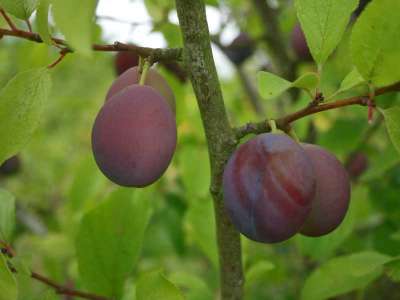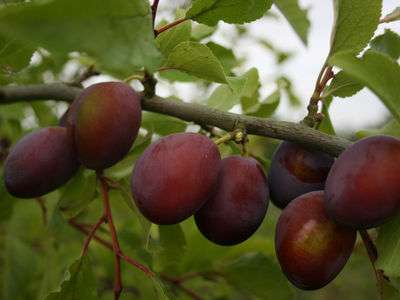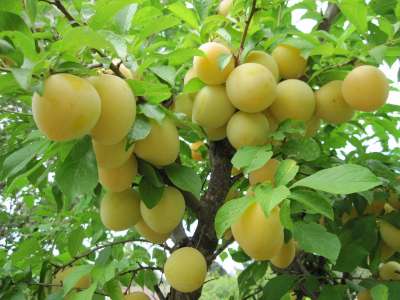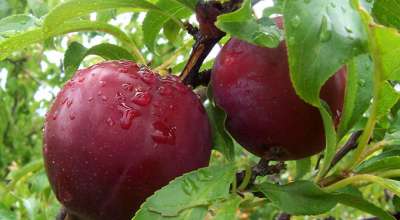Your basket is currently empty!
Plum Pests and diseases
Silverleaf
Silverleaf is the most serious disease of all that affects Plums and related trees. It is guaranteed to strike fear into the heart of any would-be fruit tree grower because there is no cure and it usually proves fatal. But try to be reassured that this disease is not that common and is often confused with a bad outbreak of mildew which causes a similar effect with the silvering of the leaves. Silverleaf can be distinguished from mildew by the main branches dying back; when these branches are cut into a red ring can be seen inside the wood. If this disease takes hold the only cause of action is to remove main branches that have been affected but usually you will lose the tree at which point it must be taken down and burnt. You can replant fruit trees in the same area but they should be unrelated – apples, pears, quinces are a safe option.It is often advised that no pruning should be carried out in the winter for plums and gages because of the ruisk of silverleaf infection. But sometimes it will be unavoidable at which time the pruning cuts should, where possible, be protected with arbrex. Unless you know you have silverleaf in your vicinity then I would not worry about it too much.
Aphids
Aphids are the problem you are most likely to encounter with plum and gage trees. They cause curling of the leaves which become sticky and distorted and may become streaked with yellow. Usually it is the ends of the branches and growing tips that are worst affected. Severe infestations can seriously affect the trees’ ability to grow so you should be vigilant and not allow these tiny terrors the opportunity to set up home. Prevention is better than cure and if you can apply a good systemic insecticide from late April onwards, at intervals directed by the manufacturer, then your trees should remain nice and clean. This will also deter other creepy crawlies such as caterpillars.
Soapy water sprayed onto the foliage is an old remedy that can also work but is not much use when aphid colonies are widespread and established. A good winter wash is worth applying during the dormant period as this will kill any overwintering colonies.
Healthy Plum Trees available to buy here!
Plum moth
This is the culprit to blame when you cut into a seemingly perfect plum only to find a maggot or grub merrily chomping away inside tucked up near the stone. Nothing is more annoying during plum-time! Understanding the life cycle of the insect is key to providing effective control. The adult moths [which are rather small] lay their eggs on the flower buds just before they open in late winter or early spring. The emerging grubs burrow into the fruit lets just as they have set and make their way inside. This leaves a hole so tiny it is just barely visible when the fruits are mature. Because the larvae [grubs] are safe hiding inside the fruit a contact insecticide is of no use. You need a systemic insecticide – one that gets taken in by the sap of the tree and kills the grubs as they feed. And timing is important too. It is no use applying too early or too late. The key time to apply it is when the eggs are being laid so aim for late winter and early spring. You only need to apply the once, this should kill the emerging larvae and provide protection for the year as this particular insect only has one generation a year.
Growing plums and gage trees in containers
Will be covered fully in a separate article. But is is an easy and very satisfying method of cultivation for these fruits. Although of most value for those short on space it is equally appropriate even if you have acres of room. Nothing is nicer than a good plum tree close at hand on the patio. As long as you choose the correct dwarfing rootstock the trees are actually encouraged to yield earlier in life than they may do in the open ground. And crops can really be quite heavy – as long as you choose the right rootstock. It is no use trying to grow a vigorously growing tree in a pot.
So make sure you opt for Pixy which is nice and compact and eminently suited to life in a container of between 20-24”. You can grow it as a small bush tree or a column style tree.
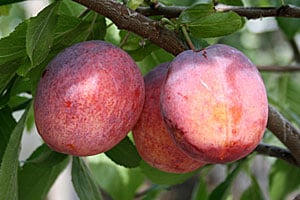
The selection of varieties should be based on criteria already described earlier in this article. The fact that the tree will be grown in pot or container will make no more difference. All varieties will be suitable and greengage trees can especially satisfactory because they seem to enjoy the added warmth and protection. If you already have plum trees elsewhere perhaps you will try something a bit different to the norm so as to extent the range and interest of your plantation.
Siting is important – the maximum amount of sunshine is of great importance not only to promote the greatest crop but also ensuring those fruits are as sweet and succulent as can be. A sheltered locality will mean the container is less likely to blow over in strong winds [one of my pet irritations here on the nursery where we have several hundred pot grown trees at any one time] And also try to make sure an easy water source is nearby so you can easily provide the amount of water required to ensure the trees wellbeing.
General purpose composts are suitable but my recommendation for container growing will always be for a loam based compost. Never use garden soil ‘though.General aftercare as described previously will also apply in most cases. But feeding is better applied as a tablet or pellet which can be acquired from your local source, or as a foliar feed.



